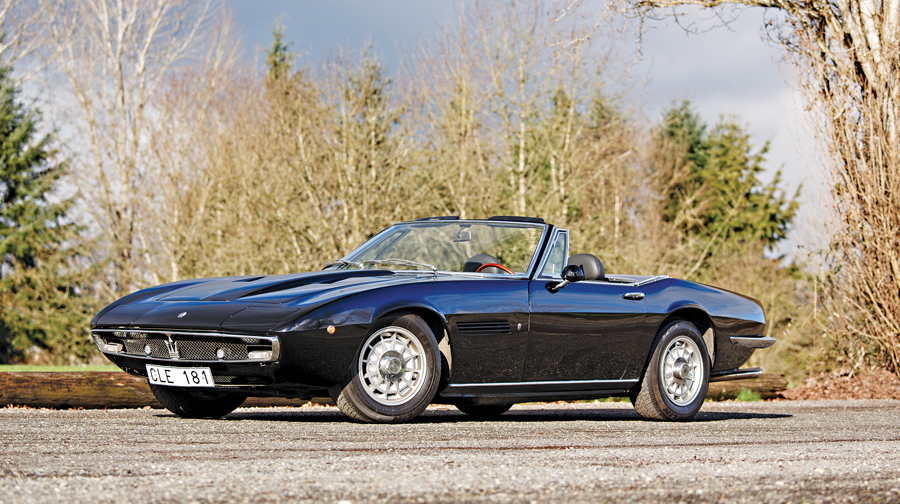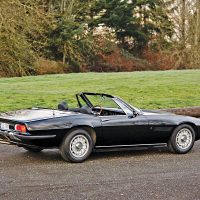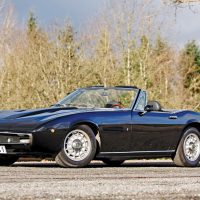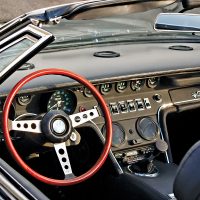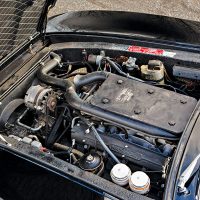SCM Analysis
Detailing
| Vehicle: | 1972 Maserati Ghibli 4.9 SS Spyder |
| Years Produced: | 1971–72 |
| Number Produced: | 46 (SS) |
| Original List Price: | $21,000 |
| SCM Valuation: | $1,256,000 |
| Tune Up Cost: | $3,500 |
| Chassis Number Location: | Engine compartment on side rail |
| Engine Number Location: | Stamped on side of block |
| Club Info: | Maserati Club International |
| Website: | http://www.maseratinet.com |
| Alternatives: | 1972–73 Ferrari 365 GTS/4 Daytona, 1966–69 Aston Martin DB6 Volante, 1964–69 Maserati Mistral Spyder |
| Investment Grade: | B |
This car, Lot 49, sold for $753,000, including buyer’s premium, at Gooding & Company’s Amelia Island, FL, auction on March 6, 2020.
By the time you are reading this, the cozy world of collector cars as it existed in March 2020 may seem rather far away. It is wonderful and remarkable that Bill Warner and his team were able to celebrate the 25th Anniversary of the Amelia Island Concours with such great style and energy. The rumblings of what was quickly approaching were ever-present, not least in the packed auction tents and rooms.
Pundits near and dear, far and despised, have already offered their opinions on the effect the coronavirus has had or will have on the collector-car market. The spinning bottle now points at me. Of course, as an experienced and accredited appraiser, I am very well aware that any opinion of value must be specific to a particular date. And this is a profile of a car sold in the pre-pandemic period, so might it be considered a bit outdated today?
Well, I think the answer is no. Let’s look at this sale and what I think it said about the market on that day in long-ago March.
Simply gorgeous, quite rare
First, consider the car itself. By most objective measures of a completely subjective topic, the Maserati Ghibli is one of the most beautiful cars ever built, and its designer, Giorgetto Giugiaro, considers it his masterpiece. So it has beauty.
The Ghibli is also among the most enjoyable-to-drive grand GTs ever built, by Maserati or any other manufacturer. They are easy to drive in town, undemanding and smooth. When taken out on the open road, they give you great confidence in fast driving and never seem to break a sweat doing it.
I’ve often observed that the Maserati V8 performs much more like its American cousins than its Italian relatives — evenly providing power from the bottom of the range to the top without fuss.
There were only 128 open Ghiblis built by the factory, and of those, a mere 46 were the 4.9-liter SS. So it has rarity.
Our subject car
Now our story begins to get a bit more complicated. The ownership trail went cold for 15 years, starting about six months after the delivering dealer put the car into the hands of the known first owner in 1972. It improves a bit as it turns up in the hands of well-known and respected dealer Ed Waterman in Fort Lauderdale, FL, in 1987.
The car’s history goes a bit soft again in the 1990s in Scandinavia, but more information is forthcoming when it comes into the ownership of Jacques Pozzo di Borgo, a very well-known figure in international Maserati circles.
There is a color change. You may have read elsewhere in this very issue of SCM my thoughts on color and how it relates to both value and appeal. A triple-black Ghibli Spyder is an attractive vehicle. However, I’m rather partial to the subtle and elegant gold this car was finished in when new. I think it’s a shame that it has been given such a slightly predictable transformation. At least the red/tan tide has long since run dry.
From an auction peak of $1.5 million for a 1971 SS at Gooding & Company’s 2016 Pebble Beach sale, prices seem to have drifted downwards. However, this is a very small market at best. It’s also rather specific — if you want a factory Ghibli Spyder and a 4.9-liter version, the opportunity doesn’t arise terribly often. There are so few of them.
What the market desires
So what are the characteristics of value that count in assessing a Maserati Ghibli? As first and foremost an object of aesthetic interest, color is key. Second, as in any limited-production, high-value vehicle, provenance is quite important. Where has it been and with whom? What did they do with it, when and why? And finally, how does it present itself today? How closely does it adhere to original standards of materials, finish and detail? Condition is also key.
We’ve already stated that the market favors the 4.9 SS over the earlier 4.7 models. So our subject car gets a plus for being one of the more-desirable variants. It also is a 5-speed manual as-built. The 4.7 Spyder that RM Sotheby’s sold last October in London was a 5-speed conversion from automatic, which brought $514,242. The lower price was not surprising, as that car experienced a double discount factor.
The SCM Median Valuation for this model has certainly been lifted by that 2016 sale for $1.5 million and a few others near or at the $1 million mark a while back.
So how does this result fit in?
Once again, the market in March read this Maserati appropriately. If a few of the characteristics of value had been different — the completeness of the provenance, the color change and the car’s slightly tired condition — the price realized might have been higher. In fact, the catalog description even suggests that the new owner might want to undertake a restoration to the original color scheme.
As it was, the car traded hands exactly where it should have, with the appropriate discount taken for the circumstances. That it sold is also indicative of an owner aware of how the market works and willing to accept its verdict, despite the aggressive $900,000–$1.1 million estimate. I would judge this well done on both sides. ♦
(Introductory description courtesy of Gooding & Company.)
